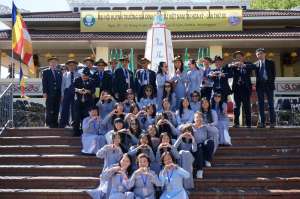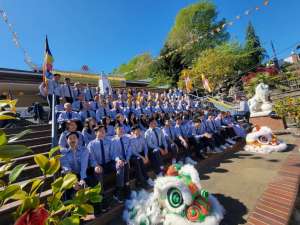
 Photo: Abdul Rahman Roslan
Photo: Abdul Rahman Roslan
Following the 1990 crackdown on the monks’ movement and the government’s efforts to show its Buddhist credentials, Buddhism became a central theme in many aspects of governance and social control. On a hill on the northern outskirts of Rangoon, the grandest pagoda to be built in years in Rangoon began to take shape. Private citizens were asked to make massive donations for the project. Called the Sweltaw Myat, or the Tooth Relic Pagoda, it was being built to honor one of the four teeth of the Buddha which are believed to have been plucked from his cremation pyre after his death in India in 483 B.C.[1]
Two of the teeth were much later taken to Sri Lanka, one to China, and the fourth disappeared in India.[2] It was the tooth from China that the SPDC wanted to borrow to show the public. China, the SPDC’s main foreign backer, agreed to loan it to bolster its relations with Burma. It was not the first time China had played “tooth-relic diplomacy” with countries in Southeast Asia. In 1955, when the Sixth Buddhist Synod was being held in Rangoon, the tooth was sent together with a delegation to Burma, where it was received by the then president, U Ba U, and Prime Minister U Nu and then taken on a procession through the streets of Rangoon and worshipped by an enthusiastic crowd. U Ba U thanked Chinese Communist Party Chairman Mao Zedong, Zhou Enlai and “the Chinese people” for the gesture. The Communist government of China was atheistic, but realized the importance of the tooth in fostering good relations with non-Communist governments in the region. Three years later, the Chinese sent the tooth to Sri Lanka for the same purpose, although this second mission was not as successful as the first one to Burma.[3]
In early 1994, the tooth left China for Burma for a second time, now on board a special Air China flight and accompanied by a delegation of eight Mahayana and four Yunnanese Theravada monks, three Tibetan lamas, and eleven lay persons including the Deputy Director of China’s Bureau of Religious Affairs, Luo San Chinai, the Burmese Minister of Religious Affairs and Chairman of the Buddha Tooth Relic Conveyance Work Committee, Lieutenant-General Myo Nyunt, and the head of Burma’s powerful intelligence apparatus, Lieutenant-General Khin Nyunt.[4]
Thousands of soldiers, civil servants, and actors in costumes of devas (celestial beings) welcomed the tooth at Rangoon’s airport, and ordinary citizens lined the streets to watch the procession. It was sent to the Maha Pasana Cave at Kaba Aye Pagoda, which had been built during the tooth’s first visit in 1955, where it was enshrined and placed on public display around-the-clock.[5]
The tooth was later returned to China, but Beijing agreed to lend the tooth to Burma periodically. Meanwhile, construction of the new tooth pagoda continued, and by July 1995 the equivalent of US$ 1.6 million had been collected from the public and foreign investors who wanted to demonstrate their commitment to the Burmese government by helping to underwrite what the New York Times called the junta’s “showcase religious project.”[6]
The tooth returned to Burma in late 1996. On December 25, while it was on the site near Kaba Aye Pagoda, two bombs went off, killing five people and injuring 17. The circumstances surrounding the bombings have never been satisfactorily explained, but the government accused “ABSDF [All-Burma Students Democratic Front] terrorists and cohorts” of being behind the incident.[7] The ABSDF, a group of students who fled the country in the wake of the 1988 massacres, denied any involvement, and no evidence has ever been produced implicating the group.
Whoever was responsible for the attack, it was now evident that the SLORC/SPDC was using Buddhism and Buddhist symbols in its repression of the opposition, just as the governments of the 1950s had done to isolate the Communists. The problem for the government this time, however, was that many monks were already part of the pro-democracy movement, so the accusations appeared to have little resonance with the public.
The military leadership has continued to utilize Buddhism as a legitimizing tool. This includes constructing a massive new pagoda in the new capitol at Naypyidaw in central Burma, called the Uppatasanti Pagoda (peace pagoda), a replica of Rangoon’s famous Shwedagon Pagoda. It reportedly houses a tooth relic of the Buddha donated by the family of President Than Shwe, who opened the pagoda in a lavish ceremony in March 2009.[8] Senior military leaders continue to sponsor pagoda renovations throughout Burma and bestow gifts to prominent monks, all of which are ostentatiously displayed in the state controlled media.
The patronage has not always been effective. The collapse of the 2,300 year-old Danok Pagoda near Rangoon in late May 2009 was seen by many Burmese as a terrible omen against the military government: the pagoda fell just a few weeks after its renovation was blessed by Daw Kyaing Kyaing, the wife of Than Shwe.[9]
The power of rumors in Burma (kaw-la-ha-la) and prophecy (dabaung), mixed with military repression and Buddhism produces a widespread suspicion amongst Burmese towards the sincerity of the regime’s religious good deeds.[10] A popular old joke inside Burma is that of a customer who believes his newly purchased television is defective: “All I ever see is green and yellow!” The joke refers to the fact that on state television there are prominent, almost nonstop displays of Burmese army generals (in green uniforms) touring the country, or granting gifts and titles to Buddhist monks (in yellow, or crimson, robes).[11]
But wielding religion as a weapon was effective in the campaign against some of the ethnic insurgent groups in the country’s border areas. In late 1994, the Karen National Union (KNU)—one of Burma’s oldest rebel groups—split along religious lines. The top leadership of the KNU had always been dominated by Christians, representing the educated Karen elite, while the majority of the rank-and-file were either Buddhist or Animist hilltribe people from the Thai border areas. Religion had never been a huge problem, but in 1994 the Buddhists broke away to form the Democratic Karen Buddhist Army (DKBA)—which immediately allied itself with the government. With DKBA defectors acting as guides, regular Burmese forces moved in on the KNU’s headquarters at Manerplaw near the Thai border. Outnumbered and outgunned, the KNU burnt its own camp on January 26, 1995, before withdrawing into the surrounding mountains or fleeing across the border to Thailand. In the weeks that followed, more KNU camps fell, and the DKBA began attacking and burning refugee camps on Thai soil. Burmese government troops always accompanied the DKBA on those raids, but the official version was always that it was “infighting between rival Karen factions.”[12]
An unintended outcome of the SPDC’s propagation of Buddhism was tension between Buddhist and non-Buddhist communities in parts of Burma not affected by the civil war—conflicts which, in the end, backfired on the government. In March 1997, Buddhist mobs, including monks, went on a rampage in Mandalay, sacking mosques in response to the alleged rape of a Buddhist girl by a Muslim. Riot police opened fire and at least one novice died from gunshot wounds.[13] The unrest spread to Moulmein, Pyinmana, Taungoo and Prome, where a curfew was imposed. Troops were also posted in Rangoon, but there was little unrest there, although the mosque where Indonesian diplomats worshipped was attacked. In a statement after the riots, the All-Burma Muslim Union, a group of Burmese Muslims in exile in Thailand, accused the government of being behind the riots and said it had “systematically caused trouble for Muslims.”[14] Many of the monks were rumored to be “imposter monks” (singang woot), undercover soldiers spreading dissension between Buddhist and Muslim communities.
In October 2003, there were more clashes between Buddhists and Muslims in Kyaukse, the hometown of SPDC chairman General Than Shwe. Five monks were arrested. Each was sentenced to 25 years in prison. A few days after that incident, a senior monk, Wiseitta Biwuntha, known as Wirathu, was also arrested in Mandalay. When 600 monks showed up to inquire about the arrest, the military blocked their way and used tear gas and fired guns. Three monks died on the spot.[15] The unrest spread to other cities as well, and 20 monks were arrested. The incident led to another “overturning of the bowl,” but the boycott was not as widespread as in 1990, or the massive monk-led demonstrations that were to take place in September 2007.
_____________________________________
[1] Philip Shenon, “Raising a Pagoda for Statecraft and Buddha’s Tooth,” The New YorkTimes, July 31, 1995.
[2] Long housed in a 13-story pagoda in Beijing, the tooth was temporarily lost when the temple was damaged by the Western expeditionary forces dispatched to crush the Boxer Rebellion at the beginning of the 20th century. Afterward, it was reportedly rediscovered by some Buddhist monks in the temple’s ruins. It is of course impossible to verify whether this is actually one of the Buddha’s teeth.
[3] John Kieschnick, The Impact of Buddhism on Chinese Material Culture, (Princeton, New Jersey: Princeton University Press, 2003), p. 43.
[4] Juliane Schober, “Buddhist Just Rule And Burmese National Culture: State Patronage of The Chinese Tooth Relic in Myanma,” History of Religions, Vol. 36, No. 3, February 1997, pp. 226-227; and J. Philip and D. Mercer, “Commodification of Buddhism in Contemporary Burma,” Annals of Tourism Research, vol.26, no.1, January 1999, pp.21-54.
[5] Ibid., p. 227.
[6] Philip Shannon, “Yangon Journal: Raising a Pagoda for Statecraft and Buddha’s Tooth,” The New York Times, July 31, 1995.
[7] “SLORC changes itinerary of Buddhist relic,” Reuters World Service, January 5, 1997.
[8] “Uppatasanti Pagoda in Nay Pyi Taw hosts a grand religious ceremony,” New Light of Myanmar, March 8, 2009, p.4. According to Burmese scholar Aung Myoe, the ‘Uppatasanti’ is a Buddhist sutra composed in the 16th century, designed to ward off crisis especially during fears of a foreign invasion. See Maung Aung Myoe, “The Road to Naypyitaw: Making Sense of of the Myanmar Government’s Decision to Move its Capitol,” (Singapore, Asia Research Institute, Working Paper no.79, November 2006), p.14.
[9] Seth Mydans, “Many Burmese See Pagoda Collapse as an Omen for the Junta,” The New York Times, June 7, 2009.
[10] Keiko Tosa, “The Chicken and the Scorpion: Rumor, Counternarratives, and the Political Uses of Buddhism,” in Monique Skidmore (ed.); Burma at the Turn of the 21st Century, (Honolulu: University of Hawaii Press, 2005), pp.154-73.
[11] Christina Fink, Living Silence in Burma. Surviving Under Military Rule, (London: Zed Books, 2009), pp.226-46.
[12] Bertil Lintner, “It’s Rangoon, not Rebels,” Far Eastern Economic Review, May 18, 1995.
[13] Patrick MacDowell, “Monk killed in Burma unrest,” Associated Press (Rangoon), March 19, 1997; Agence France-Presse, “Monks raid mosque in Rangoon,” Bangkok Post, March 23, 1997.
[14] “Burmese Increasing Security in Capital After Mosque Attack,” The New York Times, March 24, 1997.
[15] AAPPB, Burma: A Land Where Buddhist Monks Are Disrobed and Detained in Dungeons, November 2008, pp. 20-21.








